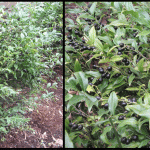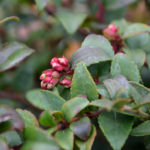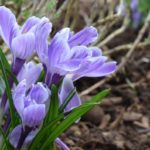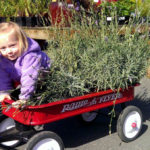This term we focused on evergreens and paid close attention to early-flowering plants. This post will focus on those early-flowering plants that give us hints that winter’s end approaches. Some you may know, and see everywhere, but some deserve more attention. I’ll break it up into two posts because there are quite a few to share!
Chinese Witchhazel (Hamamelis mollis) is a winter-blooming shrub with a lovely, contorted shape and fragrant blossoms. The delicate blossoms are an orange-yellow with a scarlet center. There are a few cultivars out there that play around with the blossom color. Tends to bloom in January here in the Willamette Valley.
Japanese Camellia (Camellia japonica) is a favorite flowering shrub for many people, although not me personally. I think the plant tends to be overused and I guess it’s just too overt for me. That said, it blooms early in late-January and carries the reddish-pink blossoms for a long time. It is an evergreen shrub with thick, glossy, dark green leaves.
Red Twig Dogwood (Cornus stolonifera) is not early flowering, but should be considered to liven up the winter garden with it’s bright red twigs. This large shrub has a lot going for it: spring flowers, red fall color, a native to this area. It does well in a range of soils, including heavy clay. You sometimes see it used in rain gardens and swales. There is a yellow-twig cultivar out there too.
Forsythia (Forsythia sp) is a loud, extroverted sign that spring is knocking on winter’s door. It blooms really early, in late-January or early February and is a bit overused. It leafs out into a somewhat uninteresting shrub that some people prune into a hedge. I prefer to see it left gangely and graceful, as shown here. The bright, mustard-yellow blooms were all over Germany on a roadtrip I took a few years back and the children hung little plastic Easter eggs off them. It was pretty cute.
Red Flowering Currant (Ribes sanguineum) is a much-appreciated native here in the Willamette Valley. It does produce small, edible berries in the summer. It is also an early-blooming shrub with chains of pink flowers that cover the shrub before leaves appear. This year it was blooming as early as the first week or two of February. I have seen some white cultivars out there too and they can look nice in a mixed planting. It is also tolerant of heavy, clay soils.
The last shrub I’ll write about in this post is more like a small tree in shape, but it fits in nicely to the garden. It is the Star Magnolia (Magnolia stellata) which opens up in late-February and can be seen blooming around town now. This small tree does tend to be over used, but I still love it! It’s white blooms are incredibly fragrant and the branches have a light, slightly-contorted shape. You will see me around town with my nose shoved in these, inhaling the promise of Spring.
Hopefully this gives you some ideas for plants to fix “holes” you noticed in the garden this year. A great garden space always has something going on with evergreen structure in the winter and blooms throughout the year. Look for a continuation of this post soon with even more early-flowering plants.











 This has become my
This has become my
 This is from South
This is from South


 All the ornamental grasses get cu
All the ornamental grasses get cu



Makes me miss the days I spent in Sweet Home, Cascadia, Eugene, and Albany as a kid! And now I know what those red twig guys are, been seeing quite a few here in the bay area recently. Thanks!
Very nice!
I love witch hazel, I am going to plant one. Thanks for the reminder!!